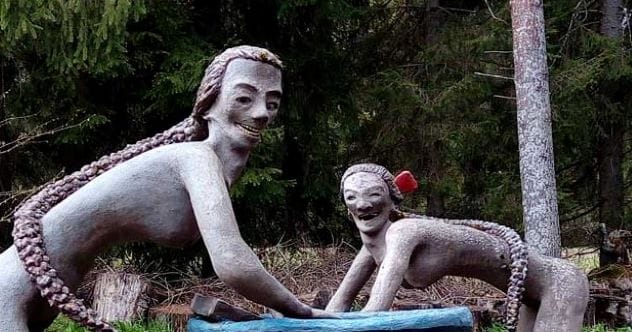Dolls, figurines, and statues have captivated human imagination for centuries. They also tap into primal fears, sparking unease and even terror in some. This phenomenon, known as automatonophobia, is the fear of human-like objects. But why do these inanimate objects evoke such strong reactions?
Whether it’s an evolutionary response to recognizing faces or a result of media influence, dolls and statues hold a unique power over our minds. If you’re brave enough, join us as we explore ten of the creepiest doll and statue havens around the globe, places where the uncanny valley meets the truly unsettling.
Island of the Dolls, Mexico
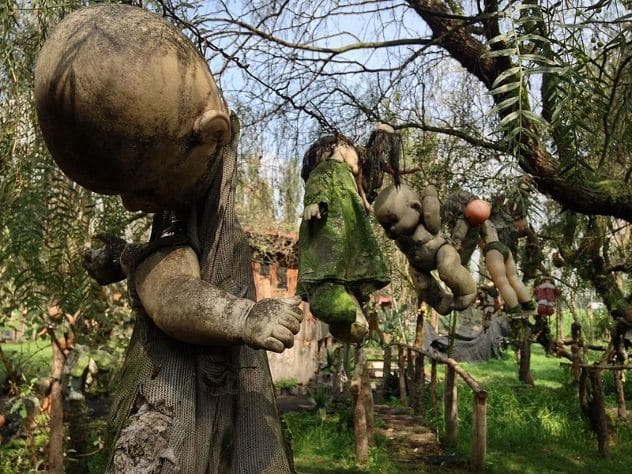
Nestled in the canals of Xochimilco, south of Mexico City, lies a place steeped in eerie legends: Isla de las Muñecas, or Island of the Dolls. The story begins in 1950 when Julián Barrera, a recluse, retreated to the island. He discovered the body of a young girl who had drowned in the canal, along with a doll floating nearby. He hung the doll on a tree, a gesture that became an unending ritual.
Julián began obsessively collecting discarded dolls from the canals and trash heaps, hanging them across the island. Over time, the collection grew to hundreds of dolls, many in disfigured states, missing limbs, or eyes. The exposure to the elements only intensified their chilling appearance. Visitors often report paranormal activity, claiming to hear the dolls whispering. In 2001, Julián was found dead in the same canal where he discovered the girl’s body. The official cause of death was a heart attack, but legend claims he died in the exact spot where he found the girl. This location became a chilling tribute to one man’s obsession and a magnet for those seeking the paranormal.
Stare Into the History of Dummies, USA
Ventriloquism, the art of “belly speaking,” has a history as turbulent as it is fascinating. Ancient Romans believed ventriloquists channeled the voices of the dead, a practice later outlawed as witchcraft by the rising tide of Christianity. It wasn’t until the 18th century that ventriloquism evolved into the comedic form we recognize today.
The Vent Haven Museum in Fort Mitchell, Kentucky, is the world’s only museum dedicated to this unique art form. Founded in 1973 by William Shakespeare Berger, it houses ventriloquist artifacts sourced from around the globe. Here, you’ll find authentic dummies used by icons like Jeff Dunham, Jay Johnson, and Willie Tyler, along with replicas of Edgar Bergen, Shari Lewis, and Bozo the Clown. With around 900 dummies in its collection, including puppet depictions of U.S. presidents, Vent Haven offers a comprehensive, if slightly unnerving, look into the world of ventriloquism. For the truly brave, the Museum even offers seasonal openings where you can “adopt” a dummy for a year for $50.
An Abandoned Park of Statues, Japan
In Toyama Prefecture, Japan, lies the Hidden Village of Statues, a place where a thoughtful idea took an eerie turn. In 1989, Mutsuo Furukawa envisioned a serene park for meditation and relaxation, featuring life-sized busts of people. He commissioned over 800 statues, modeled after his friends, family, and coworkers, as well as local legends, historical figures, and Buddhist icons.
After Furukawa’s death in 2012, the park fell into disrepair. In 2016, a local photographer rediscovered it, sparking tourist interest for all the wrong reasons. Now known as Fureai Sekibutsu no Sato, or “Village where you can meet Buddhist statues,” locals avoid it, believing the sculptures come to life at night. Thousands of visitors each year describe the experience as stepping into a forbidden zone, with the shadows cast by the statues under a full moon creating the unsettling sensation of being followed.
Another Abandoned Park of Statues, Italy
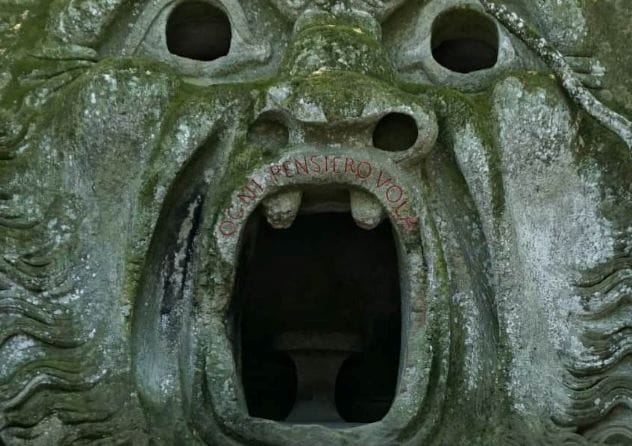
The Bomarzo Gardens in Italy, also known as the Park of the Monsters, came to life in 1547. Prince Pier Francesco Orsini, overwhelmed by personal tragedies, commissioned Pirro Ligorio to design this unique woodland as an outlet for his grief. The result is a landscape dotted with larger-than-life sculptures that have stunned visitors for generations.
Among these sculptures are an elephant mauling a Roman soldier, a giant tearing another in half, and a colossal screaming head of Orcus, the Roman god of the underworld. The park has inspired artists like Salvador Dali and poet André Pieyre de Mandiargues. Once abandoned, the park regained attention in the 1950s when Dali filmed a short documentary about it, leading to its restoration and popularity as a tourist destination.
Spend a Night With Clowns, USA
Cursed motels, menacing clowns, and haunted graveyards – these are the ingredients of nightmares. The Clown Motel in Tonopah, Nevada, blends these themes. Dubbed “America’s Scariest Motel,” it was built in 1985 as a memorial to Clarence David, a clown enthusiast, and houses over 2,000 clowns.
Adjacent to the Old Tonopah Cemetery, the motel amplifies the already eerie atmosphere. Clarence is buried here, along with miners who died in the 1911 Tonopah-Belmont Mine Fire. Reports of paranormal activity are common, including tales of a local joker who continues to play pranks from beyond the grave. A stay at the Clown Motel promises to be an unforgettable, if unsettling, experience.
Abandoned Dolls of Chernobyl, Ukraine
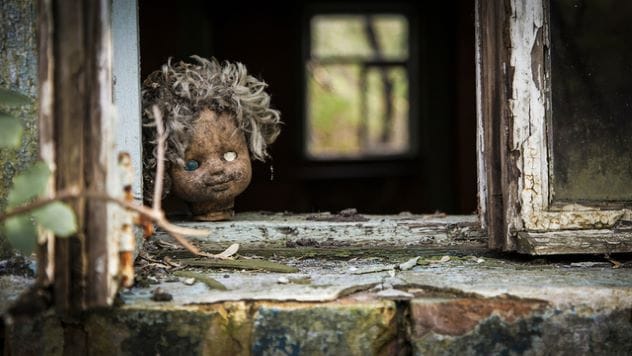
Following the Chernobyl nuclear disaster on April 26, 1986, the town of Pripyat was hastily evacuated and became a restricted area. Today, it attracts disaster tourists who come to witness the haunting remains of a once-thriving community. Among the rubble, abandoned dolls are a common sight.
These dolls are scattered throughout Pripyat – in hospitals, parks, and schools. Though many have been moved and posed by tourists, they remain a poignant symbol of the nuclear horror. Visitors are advised not to touch anything within the exclusion zone, but the allure of capturing a perfect, albeit macabre, photograph often proves too tempting.
A Village Resurrected Back to Life, Japan
Nagoro, a village nestled on the slopes of Mount Miune, is a stark example of Japan’s shrinking population crisis. Once vibrant, it transformed into a ghost town as residents moved to urban areas. Tsukimi Ayano returned to Nagoro in the early 2000s and, faced with the village’s emptiness, she began creating life-sized dolls to represent former residents who had either moved away or died.
Ayano’s dolls, made of straw, newspaper, and wood, are meticulously crafted to mimic the personalities of those they represent. Dressed in clothes and accessories that once belonged to the people, the dolls have revitalized Nagoro. The number of these “residents” now surpasses that of humans tenfold. The village has come back to life, with dolls frozen in time as construction workers, commuters, and students.
The Possum Trot, USA
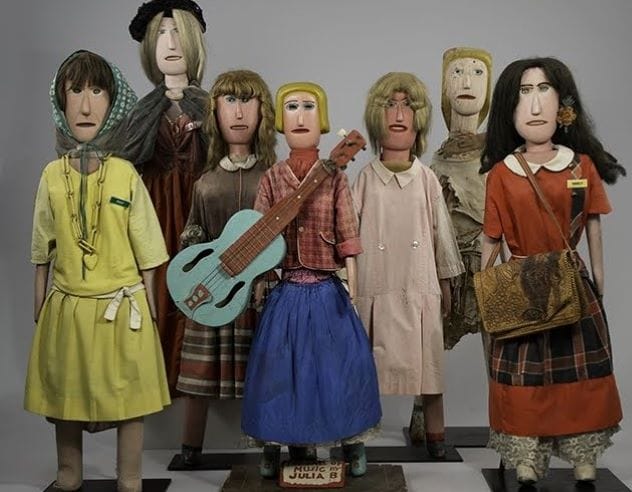
Calvin Black and his wife Ruby opened the Possum Trot in Yermo, California, offering refreshments and handmade art. Among their creations were over 80 handcrafted, nearly life-size dolls. Inspired by friends and famous women, each doll had a distinct persona, complete with unique hair, eye color, and style.
The dolls’ faces were made of redwood from salvaged electrical power poles, with sugar pine abdomens and trimmings from dumps. Equipped with built-in speakers, the dolls could interact with customers. After Calvin’s death in 1972 and Ruby’s in 1980, the Possum Trot was dismantled, but the dolls live on. Michael Hall, an art collector, donated his collection to the Milwaukee Art Museum, where they are still on display.
Pray With Ghosts, Czech Republic
Lukova’s St. George Church in the Czech Republic has endured numerous mishaps. After a piece of the roof fell during a funeral in 1968, locals abandoned the church, believing it was cursed. In 2014, a caretaker enlisted a local artist to revive it by exploiting its haunted past. Plaster models of real people, draped in shawls, were placed in the pews to resemble ghosts. These figures represent the spirits of Sudeten Germans who lived in the area before being expelled after WWII.
The ghostly congregation attracted visitors eager to photograph the specters, providing the funds needed to restore the church. Locals have also re-embraced St. George, joining the ghosts in prayer every Sunday.
Walk Into a Personal Diary, Finland
Finland’s Parikkala Sculpture Garden is home to nearly 500 concrete sculptures created by Veijo Rönkkönen. The majority are life-sized and depict the artist’s hopes, hobbies, and fears. Human sculptures are the most common subject matter, particularly a cluster of over 200 statues in yoga poses, supposedly self-portraits. Their sinister stares, ranging from blank to aggressive, capture attention. Real human teeth are embedded in some of the statues’ smirks, and hidden speakers create an unsettling atmosphere.
Rönkkönen, a recluse, rarely let guests into his garden and communicated via notes. He refused to exhibit his work, preferring to leave it in silence. Since his death in 2010, the garden attracts around 30,000 visitors annually, drawn to this unique and unsettling artistic expression.
From haunted islands to villages populated by dolls, these destinations offer a glimpse into the eerie side of art and human imagination. Whether driven by tragedy, artistic expression, or cultural beliefs, these creepy doll and statue havens around the world promise an unforgettable, spine-chilling adventure.
Which of these creepy locations would you dare to visit? Leave your comment below!


